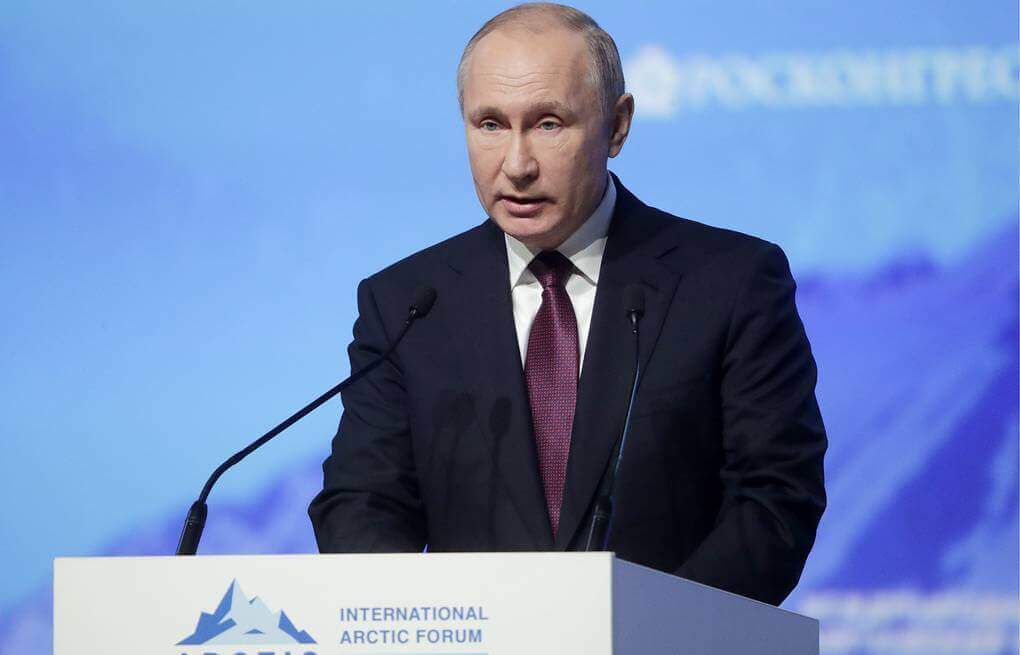On Monday, Russia’s legal information portal released a statement indicating President Vladimir Putin’s approval of a development strategy and national security provisions for the Federation’s Arctic zone until 2035.
Putin had initially announced his plan to endorse a new 15-year development strategy for the Russian Arctic in April 2019, which includes integrating measures in place by state and national programs, infrastructure investment plans, and development programs for Arctic cities and regions. On 5 March, Putin signed off on the Kremlin’s Arctic strategy, a document authored by the Ministry for the Development of the Russian Far East and the Arctic, which included the administration’s main priorities and objectives in the region, as well as mechanisms of state policy execution. Simultaneously, the State Duma, the lower house of the Russian Parliament, approved new tax release laws to ease investments in the region.
The Arctic document signed in March pinpointed the country’s national security agenda in the Arctic, highlighting the need to strengthen territorial integrity, national sovereignty and promoting stability, peace, and mutualist partnerships in the region. Developed in close consultation with Arctic communities and scientific experts, the strategy is focused on creating a high quality of life for the regional populace. The Russian Arctic is home to around 2 million people, comprising half the population of the entirety of the Arctic. Murmansk, the country’s central Arctic hub, has a population of 303,754 people. The Russian development plan is, therefore, aimed at undoing the region’s higher-than-average poverty and unemployment rates and breaking the cycle of population decrease over the past two decades.
In this vein, the March document prepared the groundwork to allow large-scale exploitation of regional natural resources to help develop the Northern Sea Route. The amended tax laws are also catered towards Moscow’s ambitions of massive oil and natural gas development in the Arctic, especially to allow investments for the development of petroleum provinces—areas where petroleum is naturally found in commercial quantities—in its remote waters, from the western Barents Sea to the Bering Sea in the east. The melting of ice in the Arctic has also opened up new avenues for energy excavation. “Russia will take the presidency in the Arctic Council in 2021, and we offer cooperation in the Arctic Region to all countries - participants in this organization, and to other states,” Putin said in April.
The new document that was approved yesterday was submitted to the government for consideration on 7 May by the Arctic Ministry, in a move towards stipulating the on-ground implementation of the state policy that was earlier greenlighted by Putin’s decree. It defines and prioritizes the areas and tasks for the development of the Russian Arctic and lays down the stages, mechanisms, and projected results of their execution.
However, the imminent environmental risks in Moscow’s Arctic plans have not been adequately addressed, which is particularly concerning as the Arctic is warming rapidly. Most recently, a massive diesel oil leak in the Arctic city of Norilsk, which was caused doubly due to the melting of an ice sheet and the negligence of a private energy firm, prompted Putin to declare a state of emergency in the region to launch a cleanup operation. Referring to Russia’s imminent chairmanship of the Arctic Council beginning next year, United States Ambassador to Russia John Sullivan said, “The Arctic Council is a very important institution that promotes this vital region, as a zone of cooperation free from conflict. And the Council itself is an institution where we can discuss sustainable development, the environment, protection and development of indigenous peoples.”
Russian Arctic Zone Development Plan Approved by Putin
The new document furthers a March decree that laid out state policy and investment plans for the development of the Russian Arctic through 2035.
October 27, 2020

SOURCE: TASS
